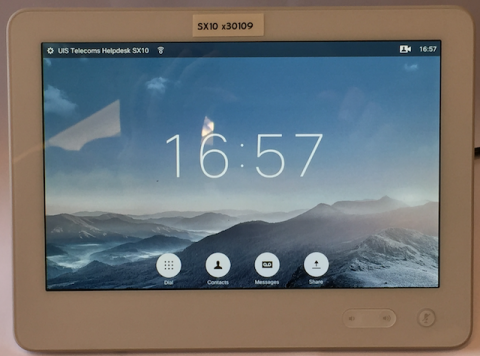The Telecoms Office are now supporting Cisco video conference units on the University phone system.
- Devices Supported
- Computer Screen Sharing
- Making & Receiving Calls
- Conference/Multi party video calls
- Calling to/from Skype (Consumer)
- Calling to/from Skype for Business
- Support & Maintenance
- Network Connectivity
Devices Supported
We only support Cisco video conference devices connected to the University phone system. Cisco currently has a range of video enabled devices. The 8845 phone and Jabber soft client can also be used for video calling. We strongly encourage potential customers to discuss your requirements with us as there may be limitations/restrictions on the features supported per device based on our CallManager software version.
All devices on the University phone system can make & receive SIP & H.323 IP video calls. URI dialing is the recommended method of making & receiving calls (e.g. 37070@cam.ac.uk) but IP dialing can be supported.
Video Units For One Person
If a single person wants to take part in a video call, they have several options available to them:
- Jabber.
- The Jabber soft client, when running on a Mac or PC with a suitable camera and microphone, can be used as a video conference end point. The Jabber soft client is free. For more information see here and here.
- 8845 Handset
- The 8845 is a standard 8800 series phone, but it has an in-built camera to support video calling. Its small screen size makes it best suited for person-to-person video calls, although it's low price (compared to the DX series) of approx. £250 and it's small desk foot pring may be appealing in some situations.
- DX80
- The DX80 look a bit like an iMac and has a 23" touch screen. The DX80 can share a laptop's screen that is connected via HDMI or via the Cisco Proximity feature to allow wireless sharing of a laptop's screen. The DX80 is approximately £1,500. The DX80 is now end-of-sale. We're waiting for the Webex Desk to become available.
Room based systems
This is a general guide to the Cisco video endpoint range. We encourage you to contact us to discuss your requirements in more detail.
All the Cisco devices support the sharing of a computer display either via a HDMI connection or the Proximity feature which allows the wireless screen sharing of laptops.
- Device Only Range
- These devices are intended for use in existing room A/V setups and they come with no integrated display. Most of the devices now mount on (or underneath) a display. Prices range from around £1,500 to nearer £10,000 depending on the size of the room the unit is expected to support. Most of the units also come with a Touch 10 LCD touch panel remote control. Some support multiple displays and support automatic speaker tracking (i.e. the camera zooms in to the person talking).
- All-in-one Devices
- The all-in-one devices are all-in-one room based units, ranging from the single 42" screen (approx £6,000) to dual 70" screens.
- Touch 10 Remote
-
The Touch 10 is a small 9.7" table type device that is remote control for many of Cisco's room based video endpoints.

NOTE: The Touch 10 remote needs its own PoE ethernet network connection often direct to the video device and not on the normal computer network.
Computer Screen Sharing - Cisco Proximity
The Cisco Proximity feature allows a Mac or PC to wirelessly share its screen with a supported video device. For proximity to work, the video end point needs to be connected to a video VLAN and the laptop must be on the UIS Eduroam or UniOfCam wireless service. If the video end point is only on the voice VLAN, Proximity will not work.
Making & Receiving Calls.
See the separate page on how to make & receive calls. We do not support making or receiving ISDN video calls. We used to suggest using the Janet Video Conference service if you needed ISDN video support, but they are soon to terminated ISDN support.
Conference/Multi Party Video Calls
Video systems need access to a bridge (also called a MCU) to make conference/multi party calls.
Telecoms have invested in a video bridge connected to the phone system. Currently, we only support ad-hoc conferences. In the future, we may also support pre-booked dial-in video conferences.
Calling To/From Skype (Consumer)
Once people find out they can make & receive video calls, a frequent question is: "Can we call people on Skype?" (And by Skype, they mean the consumer Skype service)
Currently, there is no way for us to connect to Skype for video calls (and this is what people want Skype for)
Integration With MS-Teams
As of May 2021 we are configurig the interopability between the Cisco video units and MS-Teams.
Support & Maintenance
Maintenance of Devices
Hardware maintenance is available separately. Not that this is maintenance and NOT insurance. Unlike the desk phones, Telecoms does not carry stock spares for Video devices.
Device Replacement
Unlike the Cisco telephones, we will NOT include scheduled replacement of units.
Support Method
Due to the nature of use of video conference systems, it would be impractical for the Telecoms Helpdesk to provide first line end-user support. Institutions must provide their own first line, on-site support who can work with the Telecoms Helpdesk.
It must be stressed that Telecoms Helpdesk does not provide any out-of-hours support.
Network Connectivity
All the Cisco video conference units (Except the 8845 desk phone & Jabber clients) require a separate VLAN from the normal voice VLAN. This is provided free of charge by UIS Networks.
